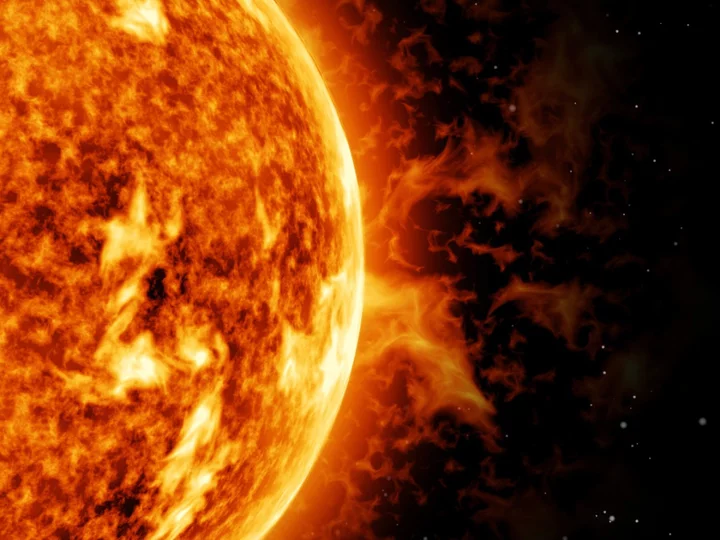
Manipur: India video shows how rape is weaponised in conflict
A video that shows two naked women being paraded by a mob in Manipur state has sparked outrage.
1970-01-01 08:00

Netflix ends password sharing in 'big market' India
Only users from a single household will be able to use an account, the streaming giant has said.
1970-01-01 08:00

Manipur: India outrage after two women paraded naked in violence-hit state
The police in Manipur state say the women were also gang raped and beaten up.
1970-01-01 08:00

A mysterious source has been sending radio signals to Earth from space for decades
An unknown source has been sending radio blasts towards Earth since at least 1988, scientists say. The researchers do not know what object is sending the radio waves towards Earth. The nature of the waves is such that they do not conform with any models that attempt to explain it. For 35 years, the source has been sending out regular 20-minute blasts of energy that vary considerably in their brightness, researchers say. The emissions appear something like the blasts that come out of pulsars or fast radio bursts, which last for milliseconds to several seconds. But the newly discovered source sends radio signals that pulsate on a period of 21 minutes – something previously thought impossible by expected explanations. Pulsars are neutron stars that spin around quickly, throwing out radio blasts as they do. When one crosses Earth, the emissions can be picked up very briefly and brightly, like being in the path of the light from a rotating lighthouse. Scientists believe that process can only work if the magnetic field of the pulsar is strong, and it is rotating quickly enough – if not, there would not be enough energy to see the pulsar from Earth. That has led to the development of the “pulsar death line”, which suggests that sources must be spinning fast and strong enough to be detected. The newly discovered object named GPMJ1839-10, however, is way beyond that death line. If it is a pulsar, then it seems to be operating in ways that scientists thought impossible. It could also be a highly magnetised white dwarf or magnetar, an extra kind of neutron star with incredibly strong magnetic fields. But they do not tend to send out emissions of this kind, researchers believe. The signals have been detected on Earth since at least 1988, scientists found by going through old records, but they had gone unnoticed by those collecting that data. After the source was detected, researchers checked radio archives and found that the source has been repeating for at least 35 years. Yet more discoveries may be made in this way in the future, said Victoria M Kaspi, a professor of physics at McGill University who did not work on the study. “Only time will tell what else lurks in these data, and what observations across many astronomical timescales will reveal,” she wrote in an accompanying article. That might include some explanation of how unusual the newly discovered source is. By examining whether there are is a similar collection of other objects in the data, researchers might be able to understand the mechanisms behind the newly discovered emissions. The findings are reported in a new paper, ‘A long-period radio transient active for three decades’, published in the journal Nature. Read More Scientists invent self-healing solar panels with ‘miracle material’ Powerful solar flare to disrupt communications, Russians warn New technique represents major breakthrough in search for aliens, scientists say
1970-01-01 08:00

The Russians Didn't Just Use Pencils in Space
A longstanding urban legend goes like this: During the space race of the 1960s, NASA spent millions developing a fancy "space pen" that could be used in zero gravity ... but the Soviets just used a pencil. This story resonates with us because NASA did act
1970-01-01 08:00

August’s Two Super Moons Are Coming: Don't Miss the Full Sturgeon Moon and Rare Super Blue Moon in 2023
All the details for when August’s two super moons are coming, and what a giant freshwater fish has to do with it.
1970-01-01 08:00

Webb telescope captures tantalizing evidence for mysterious 'dark stars'
By Will Dunham WASHINGTON Scientists for the past 15 years have been looking for evidence of a type
1970-01-01 08:00

Space investments stay flat in Q2 as market shows signs of stabilization - report
By Akash Sriram Investments in space startups stayed flat in the second quarter, a positive sign for a
1970-01-01 08:00

Large asteroid flies close to Earth – and is only spotted days later
Earth narrowly avoided an asteroid that flew past last week – and scientists did not spot the object until it had made its visit. The object, named 2023 NT1, was spotted on 15 July by the Atlas observatory in South Africa. Astronomers there say it was up to 60 metres in size. But at that point it had already made the dangerous bit of its journey: two days earlier, it had swept past Earth, at just a quarter of a distance between us and the Moon. At 60,000 miles away, that is a long way from doing any damage, but relatively close for an asteroid. As such, the asteroid didn’t pose any danger to Earth. But it was an important reminder that truly dangerous asteroids could fly towards Earth – and that we might not spot them until they are too late. That is because many asteroids, including 2023 NT1, fly towards us from the Sun. The bright light of our star can make it difficult to see anything else, especially asteroids that are relatively small at the scale of space. The European Space Agency estimates there could be a million asteroids in the same size range of 30 to 100 metres near Earth. And 98.9 per cent of them are still undiscovered, the space agency says. It has said that shows that there needs to be an improvement in the capabilities of humanity to detect such asteroids. Some are already being worked on, such as ESA’s NEOMIR, which will orbit between the Sun and the Earth and is designed to work as an early warning system for asteroids that would otherwise avoid detection, but will not launch until 2030. The asteroid 2023 NT1, at 60 metres across, is among the largest to have come so close to Earth in recent times. At that size, it could have done significant damage: the Chelyabinsk meteoroid that injured 1,500 people and damaged buildings when it fell to Earth in 2013 was only 20 metres across, for instance. From its approach last week, scientists have been able to catalogue and predict the asteroid’s movements. That should make it possible to track and spot it next time it comes close to Earth. Read More Powerful solar flare to disrupt communications, Russians warn What to expect from India’s Chandrayaan-3 mission to Moon’s south pole India launches historic mission to Moon’s south pole
1970-01-01 08:00

Powerful solar flare to disrupt communications, Russians warn
Russian scientists have warned that powerful solar flare activity on Monday may cause significant disruption for satellite and radio communications. Three solar flares observed on Sunday by the Fedorov Institute of Applied Geophysics in Moscow lasted up to 14 minutes, signalling abnormally large geomagnetic disturbances on Earth. The institute forecasted the arrival of class X flares for Monday, which are the most energetic type of solar radiation, capable of damaging electronics. Earlier this month, a giant sunspot named AR3354 grew to a size roughly 10 times larger than Earth, unleashing an X-class flare aimed directly at Earth that triggered radio blackouts in some parts of the US. The latest solar activity is expected to interfere with short-wave radio communications, used by military, maritime and emergency operators. Increased solar storm activity in recent years has led to fears of an impending solar superstorm, which some astronomers warn could lead to an “internet apocalypse”. Such powerful storms occur approximately once every 100 years, with the last major one taking place in 1921. Nasa predicts that the next peak in the Sun’s 11-year activity cycle will arrive at some point in 2025, though it is not clear yet whether this will be the once-in-a-century event that some astronomers fear. The worst on record, referred to as the Carrington Event, took place in 1859 and resulted in fires at telegraph stations. “If the Carrington Event happened today, it would have even more severe impacts, such as widespread electrical disruptions, persistent blackouts, and interruptions to global communications,” the US space agency warned in a recent blog post. “Such technological chaos could cripple economies and endanger the safety and livelihoods of people worldwide.” Research published in 2021 assessed the robustness of internet and communications infrastructure against severe space weather events The study found that coronal mass ejection events could risk disconnecting Europe from the US, with the authors urging more to be done to improve the resilience of global telecommunication networks. In March this year, Nasa announced a new artificial intelligence model capable of predicting where on Earth a solar storm may strike, giving scientists up to 30 minutes of advanced warning. Vishal Upendran, from the Inter-University Center for Astronomy and Astrophysics in India, who was involved in the AI’s development, said: “With this AI, it is now possible to make rapid and accurate global predictions and inform decisions in the event of a solar storm, thereby minimising – or even preventing – devastation to modern society.” Read More Once-in-a-century solar superstorm could plunge the world into ‘internet apocalypse’, study says Powerful solar flare responsible for blackout in US What to expect from India’s Chandrayaan-3 mission to Moon’s south pole India launches historic mission to Moon’s south pole
1970-01-01 08:00

Elton John gives evidence by videolink at Kevin Spacey's London trial
By Sam Tobin LONDON Singer Elton John appeared by videolink in a London court on Monday to give
1970-01-01 08:00

India blasts Chandrayaan-3 lander toward moon's south pole
(Refiles to fix paragraph 7 to say Chandrayaan-2 mission was launched in 2019, not 2020) By Nivedita Bhattacharjee BENGALURU (Reuters)
1970-01-01 08:00
